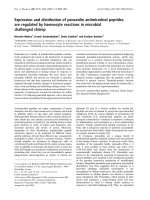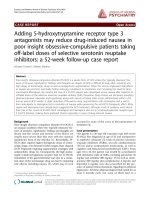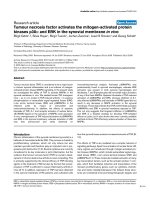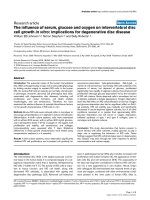Báo cáo y học: " Human T-cell leukemia virus type 2 Tax protein induces interleukin 2-independent growth in a T-cell line" ppt
Bạn đang xem bản rút gọn của tài liệu. Xem và tải ngay bản đầy đủ của tài liệu tại đây (811.14 KB, 7 trang )
BioMed Central
Page 1 of 7
(page number not for citation purposes)
Retrovirology
Open Access
Short report
Human T-cell leukemia virus type 2 Tax protein induces interleukin
2-independent growth in a T-cell line
Rie Kondo
†1,2
, Masaya Higuchi
†1
, Masahiko Takahashi
1
, Masayasu Oie
1
,
Yuetsu Tanaka
3
, Fumitake Gejyo
2
and Masahiro Fujii*
1
Address:
1
Division of Virology, Niigata University Graduate School of Medical and Dental Sciences, 1-757 Asahimachi-Dori, Niigata 951-8510,
Japan,
2
Division of Clinical Nephrology and Rheumatology, Niigata University Graduate School of Medical and Dental Sciences, 1-757
Asahimachi-Dori, Niigata 951-8510, Japan and
3
Department of Immunology, Graduate School and Faculty of Medicine, University of the
Ryukyus, Uehara 207, Nishihara-cho, Nakagami-gun, Okinawa 903-0215, Japan
Email: Rie Kondo - ; Masaya Higuchi - ; Masahiko Takahashi -
u.ac.jp; Masayasu Oie - ; Yuetsu Tanaka - ; Fumitake Gejyo - ;
Masahiro Fujii* -
* Corresponding author †Equal contributors
Abstract
Background: While human T-cell leukemia virus type 1 (HTLV-1) is a causative agent of adult T-
cell leukemia, HTLV type 2 (HTLV-2) is not associated with this malignancy. Accumulating evidence
suggests that Tax, a transforming protein of HTLV-1 or HTLV-2, plays a crucial role in the
distinctive pathogenesis of these two infections. We herein examined whether Tax2 by itself has a
growth promoting activity in a mouse T-cell line CTLL-2, and compared the activity with that of
Tax1.
Results: We found that Tax2 converts the cell growth of CTLL-2 from an interleukin(IL)-2-
dependent growth into an independent one. Cyclosporine A, an inhibitor of transcription factor
NFAT, inhibited the growth of two out of four Tax2-transformed CTLL-2 cells, but it had little
effect on two Tax1-transformed cells. While the HTLV-2-transformed human T-cell lines produce
a significant amount of IL-2, Tax2-transformed CTLL-2 cells only produced a minimal amount of IL-
2. These results thus suggest that NFAT-inducible gene(s) other than IL-2 play a role in the cell
growth of Tax2-transformed CTLL-2 cells.
Conclusion: These results show that HTLV-2 Tax2 by itself has a growth promoting activity
toward a T-cell line CTLL-2, and the CTLL-2 assay used in this study may therefore be a useful tool
for comparing the activity of Tax2 with that of Tax1 in T-cells, thereby elucidating the mechanism
of HTLV-1 specific leukemogenesis.
Findings
Human T-cell leukemia virus type 1 (HTLV-1) and HTLV
type 2 (HTLV-2) are a family of retroviruses, which share
around a 70% nucleotide identity and similar biological
properties [1-6]. For instance, both HTLV-1 and HTLV-2
can efficiently transform primary human T-cells in vitro
and establish a life-long persistent infection in humans
[7-9]. The clinical outcomes of these two infections are,
however, significantly distinctive. While HTLV-1 is etio-
logically associated with adult T-cell leukemia (ATL),
Published: 02 December 2006
Retrovirology 2006, 3:88 doi:10.1186/1742-4690-3-88
Received: 18 August 2006
Accepted: 02 December 2006
This article is available from: />© 2006 Kondo et al; licensee BioMed Central Ltd.
This is an Open Access article distributed under the terms of the Creative Commons Attribution License ( />),
which permits unrestricted use, distribution, and reproduction in any medium, provided the original work is properly cited.
Retrovirology 2006, 3:88 />Page 2 of 7
(page number not for citation purposes)
HTLV-2 is associated with only a few cases of variant hairy
cell leukemia [5,10-12].
HTLV-1 and HTLV-2 encode a transforming protein Tax1
and Tax2, respectively, which are essential for the transfor-
mation of primary human T-cells in vitro [13-16]. Accu-
mulating evidence suggests that Tax1 is a factor
responsible for the high-oncogenic activity of HTLV-1 rel-
ative to HTLV-2 [4,5]. Tax1 and Tax2 have more than 75
% amino acid identities, and they also exhibit strikingly
similar functions in infected cells [17,18]. For instance,
Tax1 and Tax2 induce the expression of a number of cel-
lular genes through several transcription factor binding
sites, such as NF-κB, CREB/ATF, SRF, and AP-1 [4,19-25].
These Tax-inducible cellular genes play a critical role in
the persistent infection in host T-cells, including the trans-
formation of human T-cells [24,25], but they alone can
not explain the pathogenic differences between HTLV-1
and HTLV-2, since the potencies of these functions are
equivalent. On the other hand, recent results identified
several differences between Tax1 and Tax2, which are
likely to be factors that are responsible for the pathogenic
difference of two infections [4,5,26-35]. Therefore, a com-
parative analysis of Tax1 and Tax2 is a promising
approach to identify a key process responsible for HTLV-1
specific leukemogenesis.
We previously showed that Tax1 transforms a mouse T-
cell line CTLL-2 from an interleukin(IL)-2-dependent
growth to an IL-2-independent one, whereas Tax2 can not
do so [32,36]. We herein reexamined the transforming
activity of Tax2 in CTLL-2 using a lentivirus vector for the
transduction of the tax gene which is much more efficient
than the electroporation method used in a previous exper-
iment. Lentiviruses encoding Tax1 or Tax2 were produced
in 293T cells, and these viruses were then infected to
CTLL-2 cells in a medium containing IL-2. At 48 hours
after infection, the infected cells were cultured without IL-
2 in a 96 well plate. Four weeks later, the number of wells
containing outgrowing cells was counted by light micros-
copy. Unlike the previous study, Tax2 transduced with a
lentivirus induced the IL-2-independent growth of CTLL-
2 cells (Figure 1). A Western blotting analysis using Tax1
and Tax2 antibodies showed that all four Tax2-trans-
formed cell lines expressed Tax2 protein but not Tax1 (Fig-
ure 2), thus confirming that the tax2-virus induced the
transformation. Like Tax1, these Tax2-transformed CTLL-
2 cells continuously grow in the absence of IL-2 for at least
three months (data not shown). These results showed that
Tax2 therefore induced the IL-2-independent growth of
CTLL-2 cells.
We previously showed that Tax2 activates IL-2 transcrip-
tion through the transcription factor NFAT, and such pro-
duced IL-2 in some HTLV-2-transformed T-cell lines
stimulates their cell growth [37]. To examine whether
NFAT plays a role in the Tax2-mediated IL-2-independent
growth of CTLL-2, we cultured Tax2-transformed cells
with cyclosporine A (CsA), a specific inhibitor of NFAT
pathway (Figure 3). Two out of four Tax2-transformed
cells showed reduced cell growth in the presence of CsA,
while the other two showed little response to CsA treat-
ment. On the other hand, parental CTLL-2 and two Tax1-
transformed cells did not show CsA-mediated growth
inhibition. These results show that the activation of NFAT
by Tax2 stimulates the cell growth of some Tax2-trans-
formed cells, but not Tax1-transformed ones. A real-time
polymerase chain reaction with IL-2-specific primers
showed that Tax2-transformed CTLL-2 cells minimally
expressed IL-2 mRNA, whereas EL-4 T-cell line treated
with phorbol myristate acetate and ionomycin produced
a significant amount of IL-2 mRNA (Figure 4). We consist-
ently detected IL-2 protein in the culture supernatant of
the EL-4 cells treated with the same mitogens, but not
those of the Tax2-transformed cell lines (data not shown).
These results suggest that NFAT-inducible gene(s) other
than IL-2 are thus involved in the Tax2-mediated growth
promotion of CTLL-2 cells.
Tax2 has been shown to be essential for HTLV-2-mediated
transformation of human T-cells [15]. It, however,
remains to be elucidated whether Tax2 by itself has a
growth promoting activity toward T-cells like Tax1 [36].
We herein showed that Tax2 can reproducibly convert a
mouse T-cell line from an IL-2-dependent growth into an
independent one. These results demonstrate that Tax2 by
itself without any other viral proteins has a growth pro-
moting activity in T-cells, thus suggesting that this growth
promoting activity of Tax2 contributes to HTLV-2-medi-
ated T-cell transformation. Since at least two functions,
apoptosis inhibition and cell cycle promotion are both
required for CTLL-2 to grow in the absence of IL-2, Tax2
can therefore replace these two functions in CTLL-2.
CsA inhibited the growth of two out of four Tax2-trans-
formed CTLL-2 cells (Figure 3), indicating that NFAT-
inducible genes are involved in IL-2-independent growth
of these Tax2-transformed cells. These results are consist-
ent with the previous results that CsA inhibited cell
growth of some but not all HTLV-2-transformed human
T-cell lines [37]. There are at least two explanations for the
distinct responses of the Tax2-transformed cells to CsA.
Tax2 may have two distinctive activities to induce IL-2-
independent growth of CTLL-2 cells. Alternatively, some
parental CTLL-2 cells may have genetic or epigenetic
change(s) conferring resistance to CsA in Tax2-trans-
formed CTLL-2 cells. In contrast to Tax2, the cell growth
of Tax1-transformed cells was little affected by CsA. This
finding is also consistent with the result that Tax1 mini-
Retrovirology 2006, 3:88 />Page 3 of 7
(page number not for citation purposes)
Tax2 induces the IL-2-independent growth of CTLL-2 cellsFigure 1
Tax2 induces the IL-2-independent growth of CTLL-2 cells. (A) tax1 and tax2B cDNAs were cloned into the lenti-
virus vector CSIIEF-RfA which has an elongation factor gene promoter for protein expression in mammalian cells. Lentivi-
ruses encoding Tax1 and Tax2B were produced by the three plasmid cotransfection method in 293T cells derived from an
embryo kidney. These lentiviruses were transduced to CTLL-2 cells (4 × 10
5
) in a final volume of 2.0 ml RPMI1640 contain-
ing 10% fetal bovine serum (RPMI/10%FBS), 8 µg/ml polybrene (Sigma) and 1 nM recombinant human IL-2 (Takeda). At 48
hours after infection, the infected cells were washed twice with phosphate-buffered saline (PBS), and the serially diluted
cells (330/well, 1000/well, 10000/well) were cultured in 96 well plate containing RPMI/10%FBS without IL-2. Four weeks
later, the number of wells containing outgrowing cells was counted by light microscopy. IL-2-independent growth (%) was
calculated as a ratio of the number of positive wells out of 96 wells. (B) Tax2 proteins in transiently lentivirus-infected
CTLL-2 cells were undetectable (data not shown). Therefore, a human T-cell line Jurkat was infected with the lentiviruses
encoding Tax1 or Tax2, and 48 hr after the infection, the amount of Tax proteins in Jurkat was measured by a Western
blotting analysis. The Western blotting assay was carried out as previously described [37]. The antibodies used were anti-
Tax1 monoclonal antibody (Taxy7) [38] and anti-Tax2B polyclonal antiserum, kindly provided by Dr. W.W. Hall (University
College Dublin) [39],.
ǩ-Tax1
ǩ-Tax2
Tax1 Tax2B
IL-2-independent growth (%)
10020 6040 80
0
Tax1
Tax2B
A)
B)
Retrovirology 2006, 3:88 />Page 4 of 7
(page number not for citation purposes)
Growth inhibition of Tax2-transformed cells by cyclosporine AFigure 3
Growth inhibition of Tax2-transformed cells by cyclosporine A. IL-2-independent CTLL-2 cells stably expressing Tax1 or Tax2B
were seeded at 2 × 10
5
cells/well on a 48-well plate and cultured in the presence of either 0.5 µM or 1.0 µM of cyclosporine (Sigma).
After culturing for the indicated days, viable cell numbers were counted by a trypan blue dye exclusion method using light microscopy.
Cell numbers㧔x10
4
/ml㧕
Days After CsA Treatment
1
23
20
60
40
80
40
0
CTLL-2
Tax2B-3
1
2
3
20
60
40
80
4
0
0
CTLL-2
Tax2B-6
CsA(-)
CsA0.5ǴM
CsA1.0ǴM
123
20
60
40
80
40
0
CTLL-2
Tax2B-7
123
20
60
40
80
4
0
0
CTLL-2
Tax2B-8
12340
20
60
40
80
0
CTLL-2
Tax1-2
12340
80
20
60
40
0
CTLL-2
Tax1-6
12
3
100
200
4
0
0
CTLL-2+IL-2
Expression of Tax protein in transformed cells
Figure 2
Expression of Tax protein in transformed cells. Cell lysates were prepared from the indicated cells, and the amounts
of Tax proteins were measured by a Western blotting analysis with either anti-Tax1 or anti-Tax2 antibodies as described in
Figure 1 [37].
T
a
x
2
-3
T
a
x
2
-
6
T
a
x
2
-
7
T
ax2
-
8
T
a
x
1
-2
T
a
x
1
-
6
ǩ-Tax1
ǩ-Tax2
Retrovirology 2006, 3:88 />Page 5 of 7
(page number not for citation purposes)
mally activates NFAT, and thus CsA can not inhibit the
cell growth of any HTLV-1-transformed T-cell lines [37].
Unlike the HTLV-2-transformed human T-cell lines sensi-
tive to CsA-mediated growth inhibition, Tax2-trans-
formed CsA-sensitive cells expressed a small amount of IL-
2 mRNA (Figure 4). Since there are several NFAT inducible
cytokines which promote T-cell growth, such as IL-4 and
IL-21, these results indicated that the NFAT-inducible
gene(s) other than IL-2 positively regulate the cell growth
of the Tax2-transformed cells, thus suggesting that HTLV-
2-transformed human T-cells may also utilize multiple
NFAT-inducible T-cell growth promoting factors for their
growth.
Accumulating evidence suggests that Tax plays a crucial
role in the distinctive pathogenesis between HTLV-1 and
HTLV-2 [4,5,26,28,29,32,34]. Therefore, further compara-
tive studies of the Tax1 and Tax2 functions in T-cells are
expected to advance our understanding of HTLV-1 leuke-
mogenesis. The CTLL-2 assay used in this study is there-
fore considered to be a useful tool for examining the
functions of Tax2 and Tax1 in T-cells, thereby elucidating
the mechanism of HTLV-1 specific leukemogenesis.
Minimum expression of IL-2 mRNA in Tax2-transformed cellsFigure 4
Minimum expression of IL-2 mRNA in Tax2-transformed cells. Total RNA was isolated from indicated Tax-trans-
formed CTLL-2 cells (lanes 3–8), or EL-4 T-cell line treated with (lane 2) or without (lane 1) 20 µg/ml phorbol myristate
acetate and 1 µM ionomycin for 5 hours using RNAiso reagent, according to the manufacturer's instructions (Takara,
Kyoto, Japan), and then total RNA (500 ng) was reverse transcribed using ExScript RT reagent kit (Takara). To quantify the
amount of IL-2 RNA, a real-time polymerase chain reaction (PCR), based on SYBR green fluorescence, was performed using
SYBR Premix Ex Taq polymerase and Takara real-time Thermal Cycler Dice (Takara). The following primers were used to
specifically amplify respective genes: mouse IL-2 gene, 5'-GGAGCAGCTGTTGATGGACCTAC-3' and 5'-AATCCAGAA-
CATGCCGCAGAG-3', mouse glyceraldehyde-3-phosphate dehydrogenase gene used as a control, 5'-TGTGTCCGTCGT-
GGATCTGA-3' and 5'-TTGCTGTTGAAGTCGCAGGAG-3'.
0.0001
0.001
0.01
0.1
1
10
EL-4
EL-4
Tax1-2
Tax1-6
Tax2-3
Tax2-6
Tax2-7
Tax2-8
PMA+Iono
+
Relative IL-2 mRNA
1
2
3
4
5
6
7
8
Retrovirology 2006, 3:88 />Page 6 of 7
(page number not for citation purposes)
Competing interests
The author(s) declare that they have no competing inter-
ests.
Authors' contributions
RK, MH, MT, LX, and YT carried out the establishing the
cell lines and the functional analysis of the cell lines. MO,
FG, and MF participated in the experimental design, data
interpretation, and the writing of the manuscript.
Acknowledgements
We thank Dr. Hiroyuki Miyoshi at RIKEN Tsukuba Institute and Dr. Wil-
liam H. Hall for the CSII-EF-RfA plasmid and anti-Tax2 antibody, respec-
tively. We also thank the Takeda Pharmaceutical Company for providing
recombinant human IL-2. We would like to express our gratituded to Chika
Yamamoto for her excellent technical assistance. This work was supported
in part by a Grant-in-Aid for Scientific Research on Priority Areas and for
Scientific Research (C) of Japan.
References
1. Seiki M, Hattori S, Hirayama Y, Yoshida M: Human adult T-cell
leukemia virus: complete nucleotide sequence of the provi-
rus genome integrated in leukemia cell DNA. Proc Natl Acad
Sci USA 1983, 80:3618-3622.
2. Chen IS, McLaughlin J, Gasson JC, Clark SC, Golde DW: Molecular
characterization of genome of a novel human T-cell leukae-
mia virus. Nature 1983, 305:502-505.
3. Azran I, Schavinsky-Khrapunsky Y, Aboud M: Role of Tax protein
in human T-cell leukemia virus type-I leukemogenicity. Ret-
rovirology 2004, 1:20.
4. Hall WW, Fujii M: Deregulation of cell-signaling pathways in
HTLV-1 infection. Oncogene 2005, 24:5965-5975.
5. Feuer G, Green PL: Comparative biology of human T-cell lym-
photropic virus type 1 (HTLV-1) and HTLV-2. Oncogene 2005,
24:5996-6004.
6. Matsuoka M: Human T-cell leukemia virus type I (HTLV-I)
infection and the onset of adult T-cell leukemia (ATL). Retro-
virology 2005, 2:27.
7. Miyoshi I, Kubonishi I, Yoshimoto S, Akagi T, Ohtsuki Y, Shiraishi Y,
Nagata K, Hinuma Y: Type C virus particles in a cord T-cell line
derived by co-cultivating normal human cord leukocytes and
human leukaemic T cells. Nature 1981, 294:770-771.
8. Yamamoto N, Okada M, Koyanagi Y, Kannagi M, Hinuma Y: Trans-
formation of human leukocytes by cocultivation with an
adult T cell leukemia virus producer cell line. Science 1982,
217:737-739.
9. Chen IS, Quan SG, Golde DW: Human T-cell leukemia virus
type II transforms normal human lymphocytes. Proc Natl Acad
Sci USA 1983, 80:7006-7009.
10. Uchiyama T, Yodoi J, Sagawa K, Takatsuki K, Uchino H: Adult T-cell
leukemia: clinical and hematologic features of 16 cases. Blood
1977, 50:481-492.
11. Takatsuki K: Discovery of adult T-cell leukemia. Retrovirology
2005, 2:16.
12. Gallo RC: The discovery of the first human retrovirus: HTLV-
1 and HTLV-2. Retrovirology 2005, 2:17.
13. Grassmann R, Berchtold S, Radant I, Alt M, Fleckenstein B, Sodroski
JG, Haseltine WA, Ramstedt U: Role of human T-cell leukemia
virus type 1 X region proteins in immortalization of primary
human lymphocytes in culture. J Virol 1992, 66:4570-4575.
14. Akagi T, Shimotohno K: Proliferative response of Tax1-trans-
duced primary human T cells to anti-CD3 antibody stimula-
tion by an interleukin-2-independent pathway. J Virol 1993,
67:1211-1217.
15. Ross TM, Pettiford SM, Green PL: The tax gene of human T-cell
leukemia virus type 2 is essential for transformation of
human T lymphocytes. J Virol 1996, 70:5194-5202.
16. Robek MD, Ratner L: Immortalization of CD4(+) and CD8(+) T
lymphocytes by human T-cell leukemia virus type 1 Tax
mutants expressed in a functional molecular clone. J Virol
1999, 73:4856-4865.
17. Slamon DJ, Shimotohno K, Cline MJ, Golde DW, Chen IS: Identifi-
cation of the putative transforming protein of the human T-
cell leukemia viruses HTLV-I and HTLV-II. Science 1984,
226:61-65.
18. Seiki M, Inoue J, Takeda T, Yoshida M: Direct evidence that p40x
of human T-cell leukemia virus type I is a trans-acting tran-
scriptional activator. Embo J 1986, 5:561-565.
19. Cross SL, Feinberg MB, Wolf JB, Holbrook NJ, Wong-Staal F, Leonard
WJ: Regulation of the human interleukin-2 receptor alpha
chain promoter: activation of a nonfunctional promoter by
the transactivator gene of HTLV-I. Cell 1987, 49:47-56.
20. Maruyama M, Shibuya H, Harada H, Hatakeyama M, Seiki M, Fujita T,
Inoue J, Yoshida M, Taniguchi T: Evidence for aberrant activation
of the interleukin-2 autocrine loop by HTLV-1-encoded p40x
and T3/Ti complex triggering. Cell 1987, 48:343-350.
21. Zhao LJ, Giam CZ: Human T-cell lymphotropic virus type I
(HTLV-I) transcriptional activator, Tax, enhances CREB
binding to HTLV-I 21-base-pair repeats by protein-protein
interaction. Proc Natl Acad Sci USA 1992, 89:7070-7074.
22. Fujii M, Tsuchiya H, Chuhjo T, Akizawa T, Seiki M: Interaction of
HTLV-1 Tax1 with p67SRF causes the aberrant induction of
cellular immediate early genes through CArG boxes. Genes
Dev 1992, 6:2066-2076.
23. Iwai K, Mori N, Oie M, Yamamoto N, Fujii M: Human T-cell leuke-
mia virus type 1 tax protein activates transcription through
AP-1 site by inducing DNA binding activity in T cells. Virology
2001, 279:38-46.
24. Sun SC, Yamaoka S: Activation of NF-kappaB by HTLV-I and
implications for cell transformation. Oncogene 2005,
24:5952-5964.
25. Grassmann R, Aboud M, Jeang KT: Molecular mechanisms of cel-
lular transformation by HTLV-1 Tax. Oncogene 2005,
24:5976-5985.
26. Semmes OJ, Majone F, Cantemir C, Turchetto L, Hjelle B, Jeang KT:
HTLV-I and HTLV-II Tax: differences in induction of micro-
nuclei in cells and transcriptional activation of viral LTRs.
Virology 1996, 217:373-379.
27. Tanaka Y, Hayashi M, Takagi S, Yoshie O: Differential transactiva-
tion of the intercellular adhesion molecule 1 gene promoter
by Tax1 and Tax2 of human T-cell leukemia viruses. J Virol
1996, 70:8508-8517.
28. Endo K, Hirata A, Iwai K, Sakurai M, Fukushi M, Oie M, Higuchi M, Hall
WW, Gejyo F, Fujii M: Human T-cell leukemia virus type 2
(HTLV-2) Tax protein transforms a rat fibroblast cell line
but less efficiently than HTLV-1 Tax. J Virol 2002, 76:2648-2653.
29. Hirata A, Higuchi M, Niinuma A, Ohashi M, Fukushi M, Oie M, Aki-
yama T, Tanaka Y, Gejyo F, Fujii M: PDZ domain-binding motif of
human T-cell leukemia virus type 1 Tax oncoprotein aug-
ments the transforming activity in a rat fibroblast cell line.
Virology 2004, 318:327-336.
30. Meertens L, Chevalier S, Weil R, Gessain A, Mahieux R: A 10-amino
acid domain within human T-cell leukemia virus type 1 and
type 2 tax protein sequences is responsible for their diver-
gent subcellular distribution. J Biol Chem 2004,
279:43307-43320.
31. Sieburg M, Tripp A, Ma JW, Feuer G: Human T-cell leukemia
virus type 1 (HTLV-1) and HTLV-2 tax oncoproteins modu-
late cell cycle progression and apoptosis. J Virol 2004,
78:10399-10409.
32. Tsubata C, Higuchi M, Takahashi M, Oie M, Tanaka Y, Gejyo F, Fujii
M: PDZ domain-binding motif of human T-cell leukemia
virus type 1 Tax oncoprotein is essential for the interleukin
2 independent growth induction of a T-cell line. Retrovirology
2005, 2:46.
33. Tripp A, Banerjee P, Sieburg M, Planelles V, Li F, Feuer G: Induction
of cell cycle arrest by human T-cell lymphotropic virus type
1 Tax in hematopoietic progenitor (CD34+) cells: modula-
tion of p21cip1/waf1 and p27kip1 expression. J Virol 2005,
79:14069-14078.
34. Xie L, Yamamoto B, Haoudi A, Semmes OJ, Green PL: PDZ binding
motif of HTLV-1 Tax promotes virus-mediated T-cell prolif-
eration in vitro and persistence in vivo. Blood 2006,
107:1980-1988.
Publish with BioMed Central and every
scientist can read your work free of charge
"BioMed Central will be the most significant development for
disseminating the results of biomedical research in our lifetime."
Sir Paul Nurse, Cancer Research UK
Your research papers will be:
available free of charge to the entire biomedical community
peer reviewed and published immediately upon acceptance
cited in PubMed and archived on PubMed Central
yours — you keep the copyright
Submit your manuscript here:
/>BioMedcentral
Retrovirology 2006, 3:88 />Page 7 of 7
(page number not for citation purposes)
35. Sheehy N, Lillis L, Watters K, Lewis M, Gautier V, Hall W: Func-
tional analysis of human T lymphotropic virus type 2 Tax
proteins. Retrovirology 2006, 3:20.
36. Iwanaga Y, Tsukahara T, Ohashi T, Tanaka Y, Arai M, Nakamura M,
Ohtani K, Koya Y, Kannagi M, Yamamoto N, Fujii M: Human T-cell
leukemia virus type 1 tax protein abrogates interleukin-2
dependence in a mouse T-cell line. J Virol 1999, 73:1271-1277.
37. Niinuma A, Higuchi M, Takahashi M, Oie M, Tanaka Y, Gejyo F, Tan-
aka N, Sugamura K, Xie L, Green PL, Fujii M: Aberrant activation
of the interleukin-2 autocrine loop through the nuclear fac-
tor of activated T cells by nonleukemogenic human T-cell
leukemia virus type 2 but not by leukemogenic type 1 virus.
J Virol 2005, 79:11925-11934.
38. Tanaka Y, Yoshida A, Tozawa H, Shida H, Nyunoya H, Shimotohno K:
Production of a recombinant human T-cell leukemia virus
type-I trans-activator (tax1) antigen and its utilization for
generation of monoclonal antibodies against various
epitopes on the tax1 antigen. Int J Cancer 1991, 48:623-630.
39. Lewis MJ, Novoa P, Ishak R, Ishak M, Salemi M, Vandamme AM, Kap-
lan MH, Hall WW: Isolation, cloning, and complete nucleotide
sequence of a phenotypically distinct Brazilian isolate of
human T-lymphotropic virus type II (HTLV-II). Virology 2000,
271:142-154.









